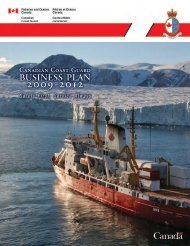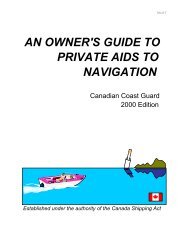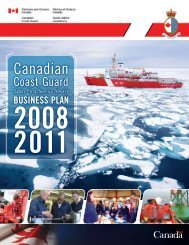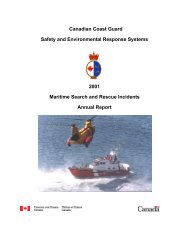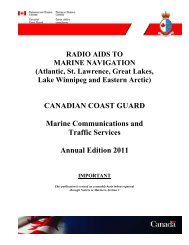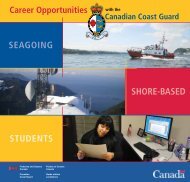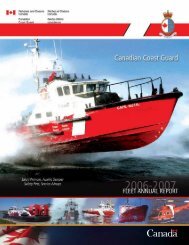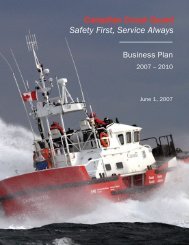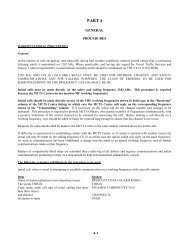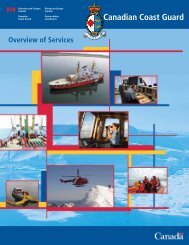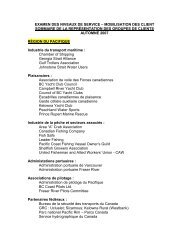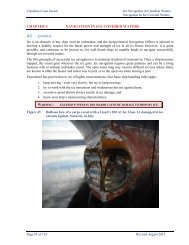RADIO AIDS TO MARINE NAVIGATION - Canadian Coast Guard
RADIO AIDS TO MARINE NAVIGATION - Canadian Coast Guard
RADIO AIDS TO MARINE NAVIGATION - Canadian Coast Guard
You also want an ePaper? Increase the reach of your titles
YUMPU automatically turns print PDFs into web optimized ePapers that Google loves.
(2) Port latitude longitude refers to the geographic position of the pilot station. Both port name and geographic position<br />
are required from U.S. flag vessels.<br />
(3) Latitude is a four-digit group expressed in degrees and minutes, and suffixed with “N” for north or “S” for south.<br />
Longitude is a five-digit group expressed in degrees and minutes, and suffixed with “E” for east or “W” for west.<br />
For example: C/4000N/03500W//<br />
(4) The “L” lines contain most of the sail plan information. As many “L” lines as needed may be used. The “L” lines<br />
contain routing data to each of the intermediate points, and to the destination. Data about all turnpoints are required,<br />
unless the voyage will follow a great circle with no delays at intermediate points. In addition to turnpoint<br />
information, data about other points along each leg are useful. Following, is the information desired for each<br />
intermediate point: navigation, method, leg speed, latitude, longitude, port or landmark name ETA estimated time of<br />
departure.<br />
For example:<br />
L/RL/125/0258N/07710W/ABACO/111200Z//<br />
L/RL/125/0251N/07910W/NWPROVCHAN/112145Z//<br />
L/RL/125/0248N/08020W/120255Z//<br />
L/RL/125//<br />
<strong>NAVIGATION</strong> METHOD IS REQUIRED. It is either “GC” for great circle, or “RL” for rhumb line.<br />
LEG SPEED is useful, but is not required. See footnote (6).<br />
LATITUDE LONGITUDE IS REQUIRED. See footnote (3).<br />
PORT OR LANDMARK NAME is useful, but is not required.<br />
ETA IS REQUIRED. See footnote (1).<br />
ESTIMATED TIME OF DEPARTURE IS REQUIRED, if the ship will lay over at the intermediate point.<br />
A final <strong>NAVIGATION</strong> METHOD is required to route the ship to its destination. A final LEG SPEED is useful, but<br />
not required.<br />
(5) True course is a three-digit group.<br />
(6) Speed is a three-digit group in knots and tenths of knots. For example, 20.5 knots would be written as 205, without<br />
a period or decimal point.<br />
(7) If the optional “V” line is used, one or more of the following is required:<br />
/MD/for physician<br />
/PA/for physician’s assistant<br />
/NURSE/<br />
/NONE/<br />
For example: V/DOC<strong>TO</strong>R/NURSE//<br />
(8) Any information provided in the Remarks line will be stored in the Amver’s automatic data processing system for<br />
later review. However, no immediate action will be taken, nor will the information be routinely passed to other<br />
organizations. The remarks line cannot be used as a substitute for sending information to other search-and-rescue<br />
authorities or organizations. However, Amver will, at the request of other SAR authorities, forward remarks line<br />
information to the requesting agencies.<br />
(9) Next report information is not currently used by the Amver System, but is expected to aid in future development.<br />
4-28



